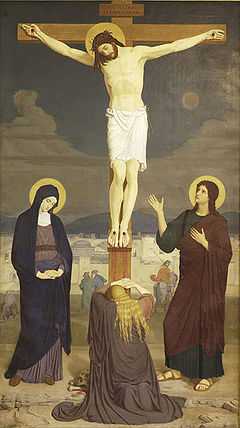Gabriel Wuger

Gabriel Wuger (1829–1892) was an artist and a Benedictine monk. He was one of the founders of the Beuron Art School in Germany in the late nineteenth century.[1]
Wuger was born on 2 December 1829 in Canton Thurgau in Switzerland.
In 1863 Wuger and two other Benedictines, Desiderius Lenz and Lukas Steiner traveled to Rome to work with the artists of the Nazarene movement. Like the Nazarenes, these artists who would become known as the “Beuronese” were in search of natural simplicity and clarity with an emphasis on essentials and conscious neglect of accidentals and details. They chose as their guiding principles the use of plain backgrounds and basic colors, a limited use of perspective and a repetition of decoration.[2]
Lenz and Wuger thought of forming a monastic community of artists. They believed that in order to make sacred art one should lead a Catholic life in community. In 1868 in Rome, they met Maurus Wolter, who had similar artistic aspirations for his young Benedictine monastery at Beuron.
Maurus Wolter wanted his monastery to play a role in the revival of Church art just as it was beginning to do in the revival of Gregorian chant (in emulation of Solesmes). Lenz was attracted to Beuron because of the abbey’s use of Gregorian chant, which he saw as parallel to his own efforts in art and architecture.
Wuger entered Beuron in 1870, followed by Steiner and Lenz in 1872. The original “Life of the Virgin” series was painted at the Emmaus Abbey in Prague under the direction of Lenz, Wuger, and Steiner between 1880-87.
In his apostolic letter Archicoenobium Casinense in 1913, on the occasion of the consecration of a crypt chapel at the abbey of Monte Cassino decorated in the style of the Beuron Art School, Pope St. Pius X likened the artistic efforts of the Benedictines of Beuron to the revival of Gregorian chant by the Benedictines of Solesmes when he wrote, “...together with sacred music, it proves itself to be a powerful aid to the liturgy”.[3]
See also
Notes
- ↑ Ehrhardt, Ingrid (2000). Kingdom of the soul: symbolist art in Germany, 1870-1920. p. 132. ISBN 3-7913-2338-5.
- ↑ Angelus Magazine, November 2003 Volume XXVI, Number 11. See at St. John's Seminary
- ↑ Acta Apostolicae Sedis 5, 1913, pp.113-17
|